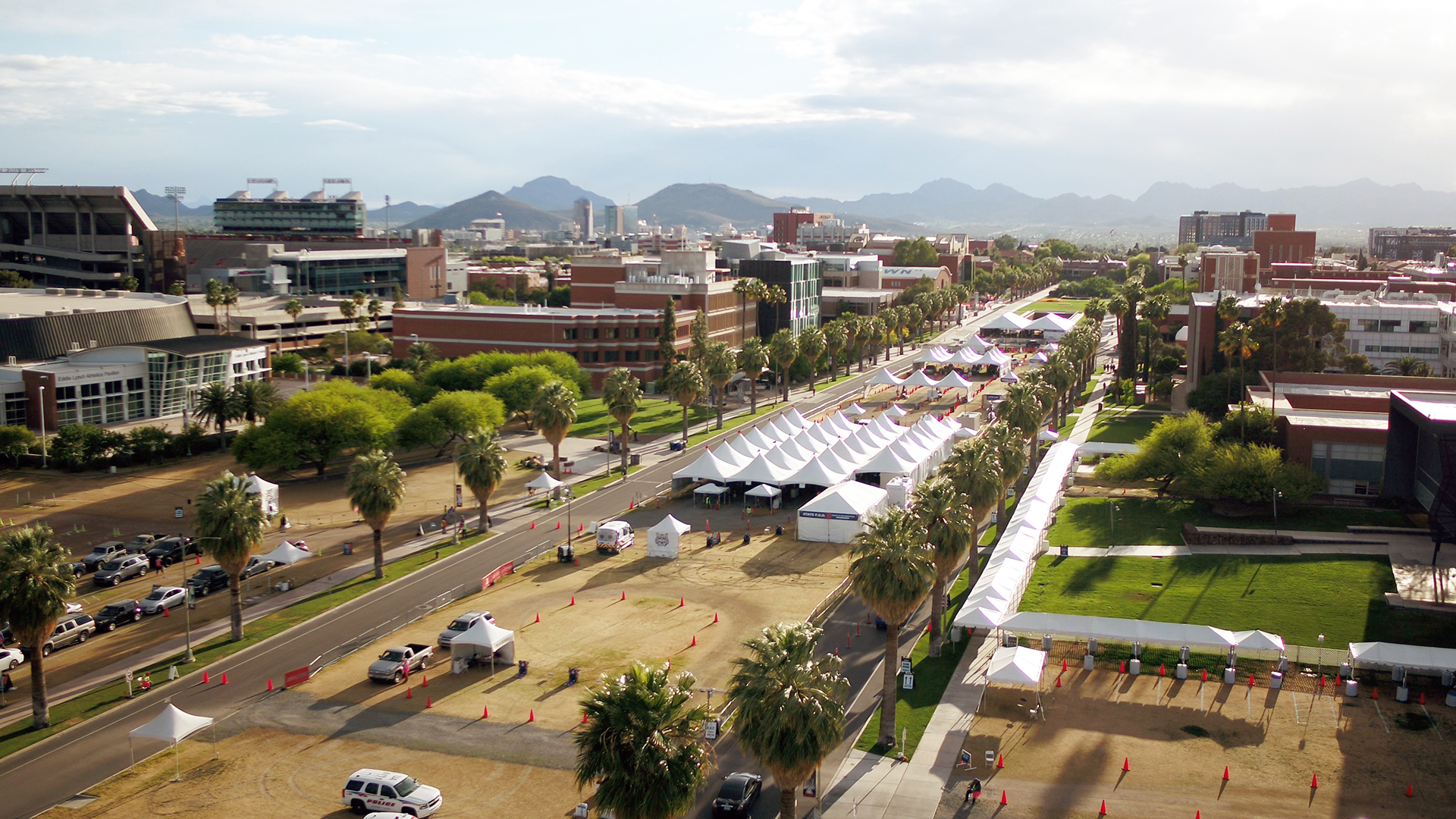Above: Drone photograph of the University of Arizona’s drive-through vaccination point-of-delivery layout, near the end of the COVID-19 mass-vaccination campaign. A few months later, the university’s grounds and labor shop restored the badly trampled turf areas in time for fall semester classes.
Earning a seat at the leadership table generally involves demonstrating an ability and willingness to respond flexibly, quickly, creatively, and effectively to challenges faced by the larger community. At the University of Arizona, UArizona Facilities Management (UAFM) found that opportunity during the COVID-19 pandemic.
In March 2020, fear and uncertainty over the rapidly spreading virus threatened to paralyze life. The pandemic declaration occurred in the middle of UArizona’ s spring break. Campus leadership initially announced that the break would be extended by two days but subsequently decided that all but a few classes would pivot to online mode for the rest of the spring semester and into the summer sessions. Most students were told not to return after spring break, and all nonessential employees were instructed to work from home until further notice
Overnight, everything was radically different, and there were many questions about how the university would pursue its teaching and research mission, or indeed if it even could under the new constraints. Chris Kopach, associate vice president (AVP) for facilities management, decided that almost all of UAFM’s 600+ employees were critical to the university’s continuing operation and, because of their skills and institutional knowledge, were in a position to address many of the questions and fears ravaging the community.
In an email that same month, UArizona President Dr. Robert Robbins emphasized that we were not looking at a sprint but a marathon and that recovery would require an unprecedented level of communication and cooperation across all segments of the university community. His approach to planning for reopening was not if but when we had COVID on campus. Those realistic expectations equipped UArizona to successfully open for in-person classes in fall 2020 and stay open throughout the entire 2020–2021 academic year. The university’s paradigm for pandemic management became “test, trace, and treat.”
One key to UAFM’s success stepping up to this challenge was the activation of the UArizona Critical Incident Response Team (UACIRT) weeks before the pandemic declaration. Dr. Richard Carmona, the 17th U.S. Surgeon General and the university’s distinguished professor of public health, led UACIRT as incident commander. As the UAFM AVP, Kopach was the logistics chief for UACIRT and proactively began to mobilize his staff to meet the new challenges facing the university and wider communities. The quickly evolving new normal put UAFM’s “can do” philosophy to the test, often requiring staff to perform quite different roles from their normal duties.
Communicate, collaborate, anticipate, and innovate
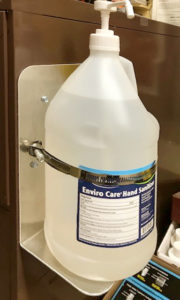
Because hand-sanitizer dispensers were in short supply, UAFM’s metals technology shop manufactured holders for large dispenser bottles and installed them at building and classroom entrances.
Before the pandemic, the UAFM leadership team routinely met once a year with the university’s 390+ building managers, typically in an Octoberfest-themed lunch where we would tell them about our services and listen to their needs. Expanding upon UAFM’s “one team” approach, which emphasizes collaborating to solve problems, Kopach began meeting with the building managers online every week during the pandemic to address their many questions and concerns. Most of them expressed feelings of being overwhelmed about how to manage their buildings in a safe way as we looked toward reopening campus. The weekly meetings became a catalyst for uniting this diverse group of people, many of whom had rarely if ever interacted with each other.
Kopach divided the campus and outlying facilities into several geographic sectors, each assigned to a project manager tasked to meet with the respective building managers to define what they needed to ensure the safety of their buildings. The project managers then oversaw the various projects for those buildings to address access, traffic flow, social distancing, signage, sneeze shields, enhanced cleaning, availability of PPE, hand sanitizer, disinfectant solution bottles, and other identified issues.
To address current and anticipated supply chain issues, UAFM’s material control buyers began to secure supplies of PPE, sanitizer, disinfectant, and enough Lexan plastic sheets for the requested 1,500+ sneeze shields that the carpentry shop manufactured and installed. The UAFM warehouse became the central repository of PPE and cleaning/disinfection supplies for the entire campus.
Hand sanitizer stations were in short supply, so the metal technologies shop fabricated hundreds of holders for large dispenser bottles that were installed at building entrances, in classrooms, and in other high traffic areas.
UAFM’s HVAC/mechanical shop evaluated each building to determine which ones needed and could support enhanced MERV-13 air filters. The team also modified ventilation settings and evaluated which spaces needed to have tighter occupancy limits due to an inability to adequately increase the number of air changes.
And there was more. Several “Germ Buster” custodial teams were trained to perform rapid isolation-level cleaning in response to known or suspected COVID-19 exposure incidents. The small engine shop filled thousands of spray bottles with disinfectant solution diluted from concentrate. The bottles were properly marked with Global Harmonization standard labels designed and printed in the UAFM paint/sign shop and distributed by custodial teams. In addition, the paint/sign shop, working with the university’s marketing department, produced and posted approximately 60,000 signs and posters in UArizona buildings related to social distancing, traffic flow, and CDC guidance.
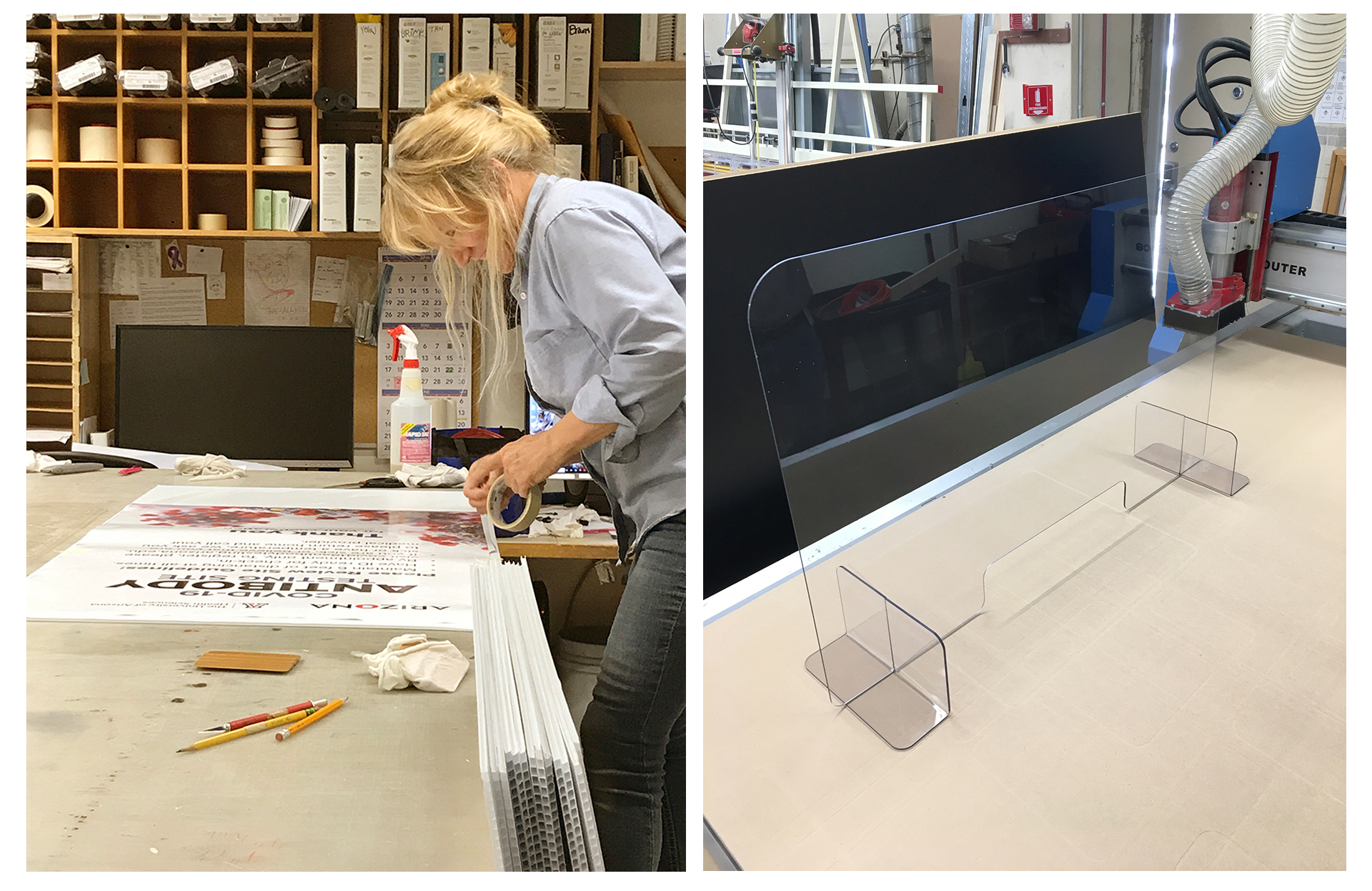
Above left: UAFM’s sign shop designed, printed, and installed more than 60,000 social distancing, traffic flow, and CDC guidance signs and markers in university buildings. Above right: Using its computer-automated router, the carpenter shop manufactured approximately 1,500 sneeze shields to protect public-facing employees.
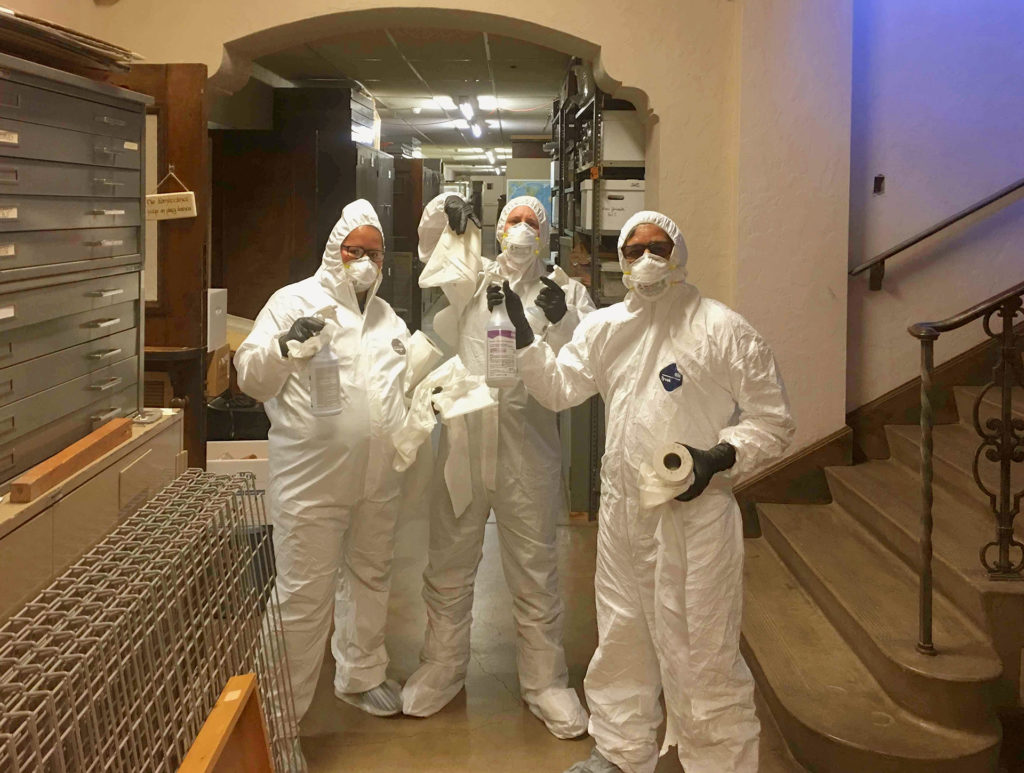
Specially trained custodial teams performed isolation-level cleaning of contaminated spaces.
Partnering across the campus
Many of the students who left for spring break did not return to campus, leaving their belongings in their dorm rooms. The few students still on campus were scattered across various residence halls, creating an immediate need to consolidate them into a few halls to free up others for cleaning and preparation as isolation dorms for COVID-positive students. UAFM custodians worked alongside Housing & Residence Life (ResLife) custodial teams to perform deep cleaning of still other emptied dorms to prepare them for reoccupation in the fall.
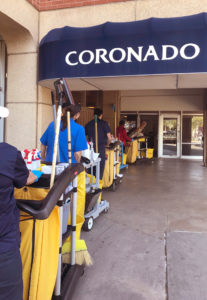
UAFM’s custodial shop assisted Residence Life custodians in cleaning vacated dorms.
ResLife faced another challenge as well: what to do with all the belongings left by nonreturning students. A contractor was hired to pack these belongings for storage. UAFM staff, in turn, joined ResLife to transport the remaining students’ belongings to their new dorms and move the packed belongings to the university’s purchasing department warehouse, for later pickup by the students and/or their families.
Upon most students’ return to campus in August 2020, new challenges emerged that were associated with controlling the spread of COVID-19 on campus and in the community. The number of requested isolation-level cleaning requests increased dramatically. The UAFM motor pool dedicated two 15-passenger vans to transport COVID-positive students from their regular dorms to one of the isolation dorms and later return them to their regular dorms after their isolation period. In addition, UAFM human resources set up a call center to periodically check in with each isolated student to see if they had any special needs and to thank them for helping to stop the virus’s spread.
Meanwhile, UArizona researchers had developed an effective wastewater testing method to detect the SARS-COV2 virus in sewage. Working with UAFM’s plumbing shop, these researchers started a successful sampling program that detected the virus in sewers associated with campus residence halls as well as some private residence halls near campus. These early detections allowed identification of cases in time to isolate the infected students and prevent rapid spreads within the dorms.
In addition, anticipating the eventual availability of vaccine, UAFM renovated an unused lab space to create a secure and reliable freezer farm capable of storing 1.6-million doses in minus-80-degree freezers, enough to support the entire county and many outlying areas.
Once UArizona had successfully remained open through fall 2020, Dr. Carmona stepped down as UACIRT incident commander and handed the reins to Chris Kopach, noting that incident command is what UAFM is all about. Kopach’s senior staff assumed several positions on UACIRT as the emphasis focused more intently on directly battling the virus.
Leveraging strengths for new deliverables
Since 2010, UAFM has played a central role in planning and executing the Tucson Festival of Books, an annual event that draws between 100,000 and 140,000 people over two days, with tents filling the eastern half of the UArizona mall. It is a complex event featuring vendors, dining places, educational presentations, and entertainment venues.
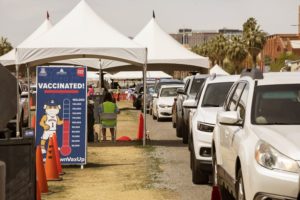
At its peak, the POD (point of delivery) delivered more than 3,000 vaccine doses per day.
Drawing from that experience, UAFM was uniquely positioned to plan and manage a large-scale vaccination point of delivery (POD) associated with the virus. Much of the infrastructure needed to support such an operation had already been installed on the mall to support the book festival and other large events. We also had built relationships with contractors that supply tents, tables, chairs, HVAC equipment, portable restrooms, etc. Therefore, we began planning a vaccination POD in spring 2020, long before the vaccines became available.
On January 19, 2021, in cooperation with Pima County Health Department, the UArizona POD began operation as a combination drive-through and sit-down vaccination site. It gradually ramped up operations, making adjustments along the way, to eventually achieve up to 4,400 vaccinations in a 12-hour day. The success of the operation caught the attention of the Arizona governor’s office, and on February 18, the operation transitioned from a Pima County POD to a state POD. By time it shut down on June 25, the POD had delivered more than 243,000 vaccine doses.
Besides senior staff serving as UACIRT section chiefs, many UAFM employees worked part- or full-time at the POD, alongside the 300 volunteers and staff from many UArizona departments
The POD’s success was largely due to the diverse spectrum of staff and volunteers involved, ranging from university students to retirees. It created an energy and excitement that reinvigorated the community after the intense isolation brought about by the pandemic. University contractors and vendors also donated time, services, and materials. This rich diversity of skills and perspectives contributed to the agility of the operation.
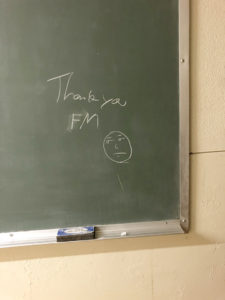
This message, written on a chalkboard in one of the almost-vacant buildings during the shutdown, says it all.
The pandemic was a challenging time; most of us were touched by personal loss or financial challenges. Yet it also presented opportunities for positive changes. Some have referred to it as “the great reset,” and indeed UAFM used the pandemic to re-examine everything we did, asking if there were more effective and efficient ways to get the same or better results. We realized that our strength lay not only in our internal sense of community, but also in our being an active and effective part of the larger community.
In one of Dr. Robbins’s periodic email updates to the campus community, Mona Arora, a UArizona professor of public health and cochair of the UACIRT Vaccine Task Force, said that UAFM stood alone in being the only facilities team in the country to manage such a massive vaccination effort on a university campus. It happened because we chose to be a catalyst for hope in the midst of the most challenging time of our generation, and to bring people together and empower them to work as a team to address those challenges. The experience was immensely gratifying, uniting us as part of a larger team and putting our abilities and customer service attitude on open display, cementing our relationships with other entities around the university and broader community.
And that’s a good way to earn a seat at the table!
Mark Marikos is a content developer on the UArizona Facilities Management (UAFM) team in Tucson, Arizona. He pursued graduate studies at UArizona in geosciences and returned to the university in 2001 to join the UAFM team, where he managed the university’s water systems and on-campus utility metering for 13 years before transitioning to writing and other positions.
